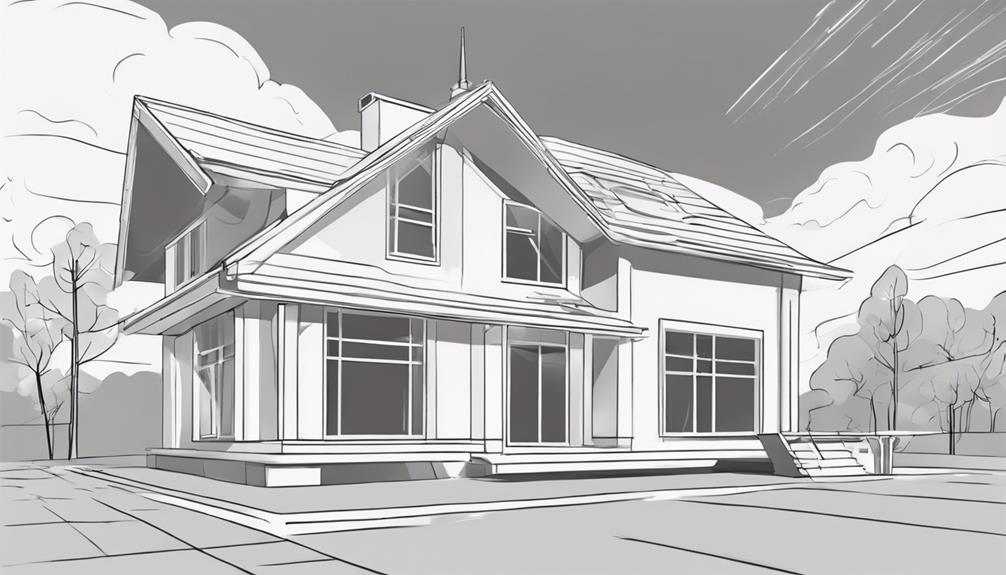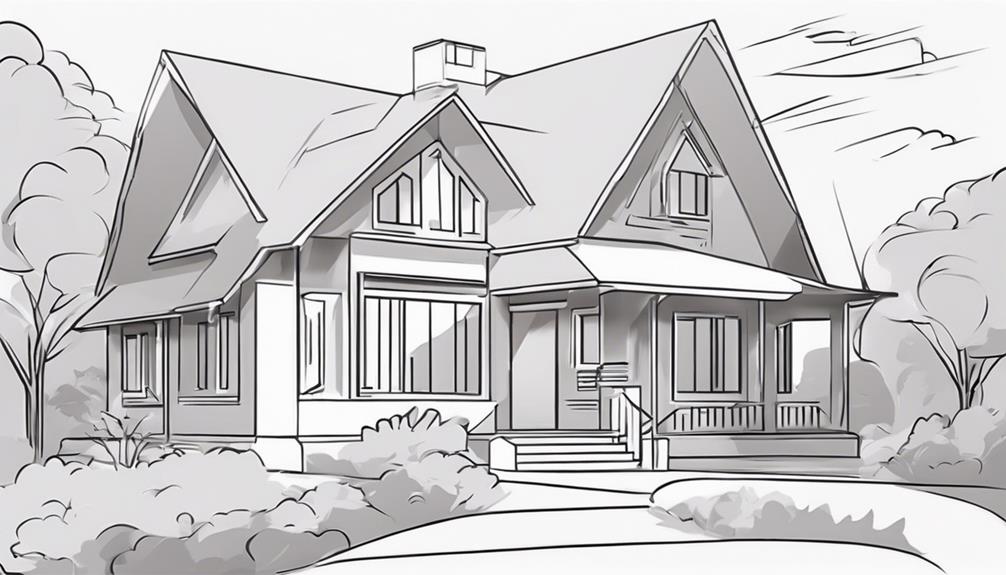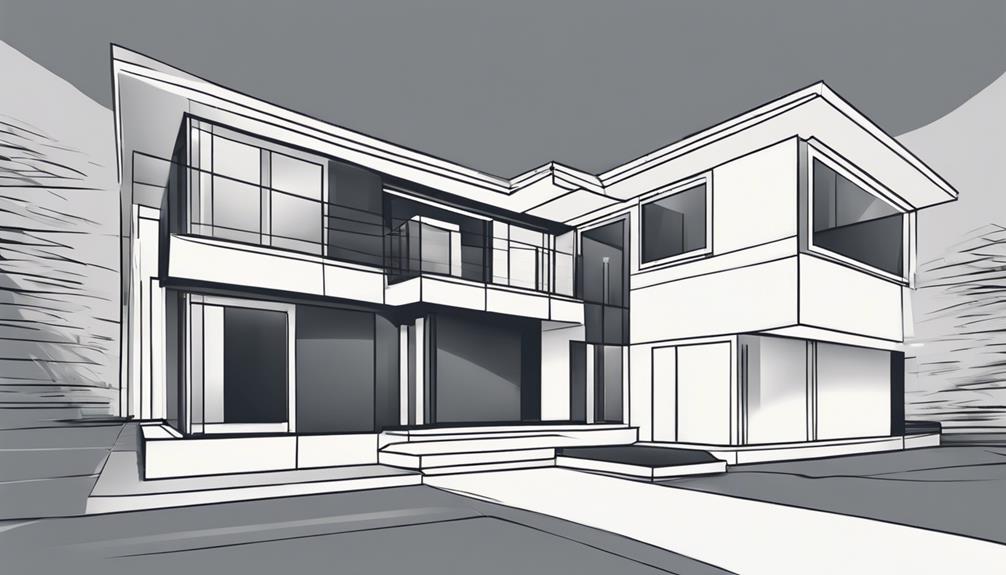Looking at different roofs in a neighborhood shows that color affects both looks and function. The best roof color depends on energy saving, local weather, and the house's design.
While many factors play a role in choosing the right color, one stands out for its balance of beauty and usefulness. This might not be what you expect.
Key Takeaways
- Light-colored roofs are best for energy efficiency and lower cooling costs.
- Consider architectural style when choosing roof colors for aesthetic harmony.
- Roof color impacts maintenance needs and longevity, with light colors requiring less upkeep.
- Prioritize sustainable and environmentally friendly options for energy-efficient living environments.
Light-Colored Roofs

Choosing a light-colored roof can help in reducing energy costs and maintaining a cooler indoor temperature during hot weather. Light-colored roofs have excellent reflective properties that allow them to bounce off a significant amount of sunlight, preventing your home from absorbing excessive heat. By reflecting sunlight, these roofs create a cooling effect, which can translate into lower air conditioning usage and decreased energy bills.
The reflective properties of light-colored roofs are especially beneficial in warmer climates where high temperatures are common. These roofs help in minimizing heat absorption, keeping your home more comfortable without relying heavily on air conditioning. Additionally, the cooling effect provided by a light-colored roof can contribute to a more sustainable and energy-efficient living environment.
Dark-Colored Roofs
Consider the impact of opting for a dark-colored roof on your home's energy efficiency and indoor temperature regulation. Dark-colored roofs have a higher heat absorption rate compared to lighter shades. This increased heat absorption can lead to higher indoor temperatures during warm months, potentially raising cooling costs. While dark roofs can help with snow melting in colder climates, they may not be the best choice for warmer regions due to the extra heat they trap.
Regarding visual impact and curb appeal, dark-colored roofs can add a bold and dramatic touch to your home's exterior. Dark roofs can create a striking contrast against light-colored walls or landscaping, giving your home a sophisticated look. However, it's important to take into account the overall aesthetic of your neighborhood and make sure that a dark roof complements the style of your home.
Before deciding on a dark-colored roof, weigh the benefits of its visual appeal against the potential increase in cooling costs and indoor temperatures.
Energy-Efficient Roof Colors

For best energy efficiency, selecting a roof color that reflects sunlight can help regulate indoor temperatures and reduce cooling costs. Energy-efficient roof colors often incorporate reflective coatings that bounce sunlight away from the house, minimizing heat absorption. By choosing a light-colored roof with reflective properties, you can greatly decrease the amount of heat that's transferred into your home, leading to cost savings on cooling expenses.
In addition to the financial benefits, opting for energy-efficient roof colors also has a positive environmental impact. Dark-colored roofs tend to retain heat, contributing to the urban heat island effect and increasing energy consumption. By contrast, lighter hues and reflective coatings help reduce heat retention, lowering the demand for air conditioning and decreasing greenhouse gas emissions.
When considering roofing options, prioritize energy efficiency by selecting colors that promote heat reflection. This small choice can have a huge impact on both your finances and the environment.
Climate Considerations
To optimize your roof color choice for energy efficiency, it's essential to take into account the climate considerations of your specific location. The color of your roof can have a significant environmental impact by affecting the cooling effect within your home. In warmer climates, lighter roof colors such as white or light gray can reflect sunlight and heat away from your house, reducing the need for excessive air conditioning and lowering energy costs. On the other hand, in colder regions, darker roof colors like black or dark brown can absorb heat and help with snow melt on the roof, potentially reducing the risk of ice dams.
Besides the environmental aspect, the color of your roof also plays a role in visual aesthetics and property value. Choosing a roof color that complements the style and color scheme of your home can enhance its overall appearance and curb appeal, potentially increasing its market value. When selecting the best roof color, consider both the climate impact and the visual impact it will have on your property.
Architectural Style Impact

When evaluating the impact of roof color on architectural style, your choice should harmonize with the design elements of your home for a cohesive and visually appealing look. Traditional homes often pair well with neutral roof colors like shades of brown, gray, or black, enhancing the classic charm of the architecture.
On the other hand, modern homes can benefit from bold roof colors such as deep blues, vibrant reds, or sleek blacks to create a striking contrast and a more contemporary feel.
For traditional styles, earthy tones like terracotta or dark green can add a touch of elegance, while modern designs may be complemented by unconventional choices like charcoal gray or even metallic finishes. Consider the overall aesthetic you want to achieve – whether it's blending in seamlessly with a traditional design or making a statement with a modern twist.
Maintenance and Longevity
Consider the durability and upkeep requirements of different roof colors before making your final decision. When choosing a roof color, it's essential to think about long-term durability and weather resistance. Opting for a color that can withstand various weather conditions will save you time and money on maintenance in the long run.
To help you make an informed decision, here is a comparison table showcasing the maintenance needs and longevity of different roof colors:
| Roof Color | Maintenance Needs | Longevity |
|---|---|---|
| Dark Colors | High | Moderate |
| Light Colors | Low | High |
| Neutral Colors | Moderate | High |
| Bright Colors | High | Low |
| Earth Tones | Low | High |
Conclusion
Selecting the right color for your roof involves balancing energy efficiency, the local climate, and your home's architectural style. Lighter colors reflect sunlight, helping keep interiors cooler, while darker roofs are better suited for absorbing heat in cooler climates. Maintenance and durability are also crucial considerations.
Ultimately, the ideal roof color is one that meets your specific needs and aesthetic preferences, inviting the question: How will your choice influence not just your home, but also its surroundings and energy consumption over time?

